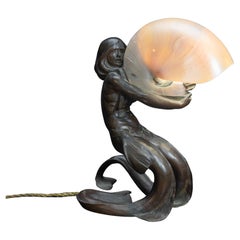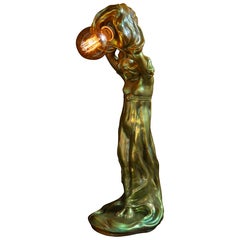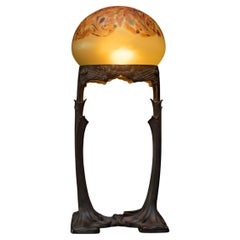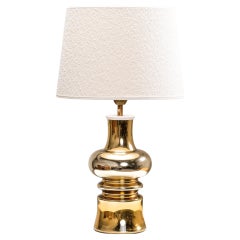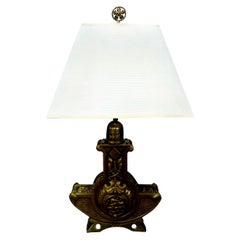Galerie Fledermaus Lighting
to
3
3
Height
to
Width
to
3
3
3
3
3
2
2
1
1
1
3
2
1
3
3
3
2
1
1
1
Secessionist Bronze Mermaid Shell Lamp by Gustav Gurschner
By Gustave Gurschner
Located in Chicago, US
GUSTAV GURSCHNER (Austrian, 1873-1970), a sculptor, attended the School of Applied Arts in Vienna in 1888. Working under several artists, his time in Paris in 1897 proved to be most ...
Category
Antique Early 1900s Austrian Art Nouveau Table Lamps
Materials
Brass, Wire
Art Nouveau Maiden Lamp by Lajos Mack for Zsolnay
By Lajos Mack, Zsolnay
Located in Chicago, US
Established in 1853 by Miklós Zsolnay, Zsolnay began as a small business producing basic stoneware and earthenware. Ten years later Miklós’ son, Vilmos, joined the company and led it...
Category
Antique Early 1900s Hungarian Art Nouveau Table Lamps
Materials
Earthenware
Secessionist Bronze & Balloon-Glass Table Lamp by Gustav Gurschner, Johann Loetz
By Johann Lötz Witwe, Gustave Gurschner
Located in Chicago, US
Art Nouveau BALLOON GLASS TABLE LAMP, by Gustav Gurschner and Johann Loetz Witwe, c. 1904, the glass dome in a frosted yellow iridescent ground is crow...
Category
Antique Early 1900s Austrian Art Nouveau Table Lamps
Materials
Brass
Related Items
Golden Art Glass Table Lamp by Gustav Leek for Flygsfors, Sweden, 1960s
By Flygsfors, Gustav Leek
Located in Karis, Nyland
An exceptional example of Swedish mid-century lighting, this golden art glass table lamp was designed by Gustav Leek for Flygsfors in the 1960s. With its sculptural silhouette and lu...
Category
Vintage 1960s Swedish Scandinavian Modern Table Lamps
Materials
Glass
Austrian Art Nouveau Bronze Lamp
Located in Houston, TX
Lovely period Austrian Art Nouveau bronze table lamp. This beautifully detailed, high quality Austrian bronze lamp has been newly wired and would w...
Category
Vintage 1910s Austrian Art Nouveau Table Lamps
Materials
Bronze
Rhapsody Table Lamp in Black Shell & Bronze-Patina Brass by Patrick Coard Paris
By Patrick Coard
Located in New York, NY
The Paris based label has distinguished themselves since their launch, with their iconic use of shagreen mixed with brass and other exotic materials. All furniture is handcrafted by ...
Category
21st Century and Contemporary Philippine Art Deco Table Lamps
Materials
Brass
$1,205 / item
H 19.69 in W 3.94 in D 3.94 in
Antique American Art Nouveau Bronze & Leaded Glass Table Lamp by Wilkinson, 1910
By Wilkinsons
Located in Portland, OR
Antique American bronze and leaded glass table lamp by Wilkinson, circa 1910.
The three light lamp having a dome shaped shade with striated leaded glass green & ivory tiles and havin...
Category
Vintage 1910s American Art Nouveau Table Lamps
Materials
Bronze
$2,625 Sale Price
25% Off
H 22 in Dm 18.25 in
Cosmo Table Lamp in Shagreen, Shell and Bronze-Patina Brass by Kifu, Paris
By Kifu Augousti
Located in New York, NY
The Paris based label has distinguished themselves since their launch, with their iconic use of shagreen mixed with brass and other exotic materials. All furniture is handcrafted by skilled artisans, ultimately making each piece unique, designed in Paris and produced in the Philippines.
The Cosmo table...
Category
21st Century and Contemporary Philippine Art Deco Table Lamps
Materials
Brass
$2,240 / item
H 33.5 in Dm 10 in
Monumental Pair of Italian Glass Table Lamps, Biomorphic Balloon Lamps
Located in Miami, FL
Illuminate your space with this stunning monumental pair of Italian biomorphic blown glass balloon lamps.
The lamps feature a rarely seen attached ...
Category
Mid-20th Century Italian Mid-Century Modern Table Lamps
Materials
Glass, Art Glass, Blown Glass
$2,680 Sale Price / set
20% Off
H 25.5 in Dm 15 in
Art Nouveau Table Lamp, 1910's
Located in Praha, CZ
Beautiful antique Art Nouveau lamp made of copper alloy, patinated to old bronze. Produced in former Czechoslovakia in the very beginning of 2...
Category
Early 20th Century Czech Art Nouveau Table Lamps
Materials
Metal
Geometric Table Lamp in Shagreen, Shell and Bronze Patina Brass by R&Y Augousti
By R & Y Augousti
Located in New York, NY
The Paris based label has distinguished themselves since their launch, with their iconic use of shagreen mixed with brass and other exotic materials. All furniture is handcrafted by ...
Category
21st Century and Contemporary Philippine Art Deco Table Lamps
Materials
Brass
$2,410 / item
H 29.93 in W 13.78 in D 13.78 in
Peacock Table Lamp in Shagreen or Shell w/bronze patina brass by R&Y Augousti
By R & Y Augousti
Located in New York, NY
The Paris based label has distinguished themselves since their launch, with their iconic use of shagreen mixed with brass and other exotic materials. All furniture is handcrafted by ...
Category
21st Century and Contemporary Philippine Art Deco Table Lamps
Materials
Brass
$2,350 / item
H 36.62 in W 9.45 in D 9.45 in
Art Nouveau Austrian Bronze Table Lamp with Loetz Styled Art Glass Shade
Located in Hamilton, Ontario
This antique table lamp is unsigned, but presumed to have originated from Austria and date to approximately 1900 and done in the period Art Nouveau style. The lamp base is composed o...
Category
Early 20th Century Austrian Art Nouveau Table Lamps
Materials
Bronze
Majorelle Art Nouveau Lamp
By Atelier Majorelle
Located in NANTES, FR
Majorelle Art Nouveau lamp
Large lamp around 1900 foot in gilded bronze and lampshade in alabaster.
Very good quality of bronze and pretty floral m...
Category
Early 20th Century French Art Nouveau Table Lamps
Materials
Alabaster, Bronze
Pair of Bronze Nautilus Shell Lamps
Located in London, GB
Pair of bronze table lamps sitting on black marble bases in the shape of a nautilus shell.
Category
Vintage 1970s Belgian Mid-Century Modern Table Lamps
Materials
Marble, Bronze
